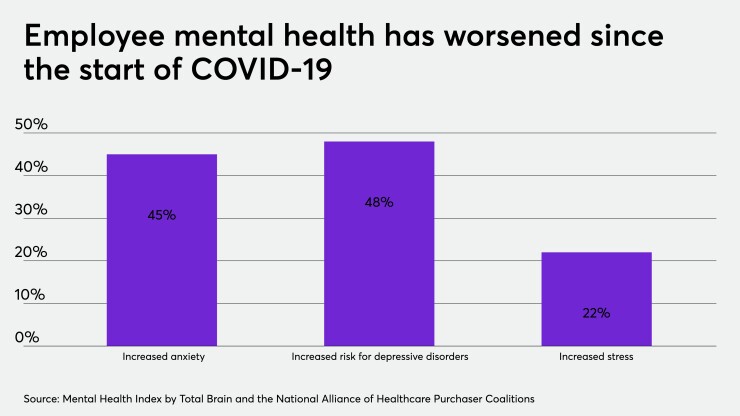Although supporting employees with benefits and resources to help them manage mental health issues is nothing new, the demand for and focus on
Even before demand for mental health services ratcheted up during the pandemic, it was often difficult for employees to access the care they needed. Many mental health care providers don’t accept insurance because of low reimbursements, which can put care out of reach. And there are fewer providers available as more mental health specialists retire and fewer new providers join the field.
Read more:
Proactively addressing employee mental health is essential. Not only do employees living with these conditions face the possibility of their condition becoming more severe if left untreated, mental health issues can also impact productivity and absenteeism. And as more people are
One option that employers are exploring to expand access to care and promote well-being is digital mental health tools. There are a range of different approaches to digital mental health care, from apps designed to arm employees with coping skills that help them manage stress or the symptoms of anxiety to remote video or phone therapy sessions with mental health specialists and video, audio and written educational content on managing mental health.
Read more:
Key considerations when building an employee digital mental health strategy
Before choosing tools and resources to offer employees, take some time to develop a digital mental health strategy that meshes with and enhances the other mental health benefits you offer.
- Set your goals. Are you trying to improve access to care? Fill gaps in your current mental health care benefits or provider networks? Educate employees about mental health and help destigmatize seeking care and talking about mental health? Address a specific issue that employees have raised around stress and mental wellbeing?
- Decide who will have access to the tools. Some companies only provide access to digital mental health tools to employees, while others include spouses, partners and children. While it may be less expensive to limit access to the resources, bear in mind that when an employee’s spouse, partner or child is living with a mental health or substance use issue, the employee is still affected. That can lead to an increase in absenteeism and presenteeism and a decrease in productivity.
- Assess the available resources. Digital mental health is a relatively new field. Not all tools are created equal. Choosing apps can be particularly challenging since most aren’t reviewed by experts or regulated by medical review bodies. The American Psychiatric Association created a
site that provides in-depth information about hundreds of apps. Criteria considered in the evaluations include whether the app has evidence-based studies that support it, how/if it protects user privacy and data, whether the mental health providers on the platform are licensed and how the app handles users in crisis.
- Have a plan to build employee engagement with the resources. The best digital health strategy in the world won’t be effective if your employees don’t understand and use the tools and resources you provide. Your strategy should include an ongoing plan to educate employees and family members about your digital mental health offerings, as well as regular reminders about the availability of the tools and how employees can access them.
- Ensure the tools are accessible for all employees. When choosing tools, consider the needs of your diverse employee population. Do you need tools in multiple languages? Are the tools accessible for people with disabilities? Do they offer 24/7/365 access or are services available to support employees in multiple time zones or countries? Do the tools have operating system or device-specific requirements and, if so, do all your employees have the technology they need to easily access the tools?
- Decide how you will measure the success of your digital mental health offerings. Your measurements of effectiveness may include reduction of healthcare costs, fewer missed workdays and/or increased productivity, employee engagement and satisfaction, and an increase in access to mental health care.






